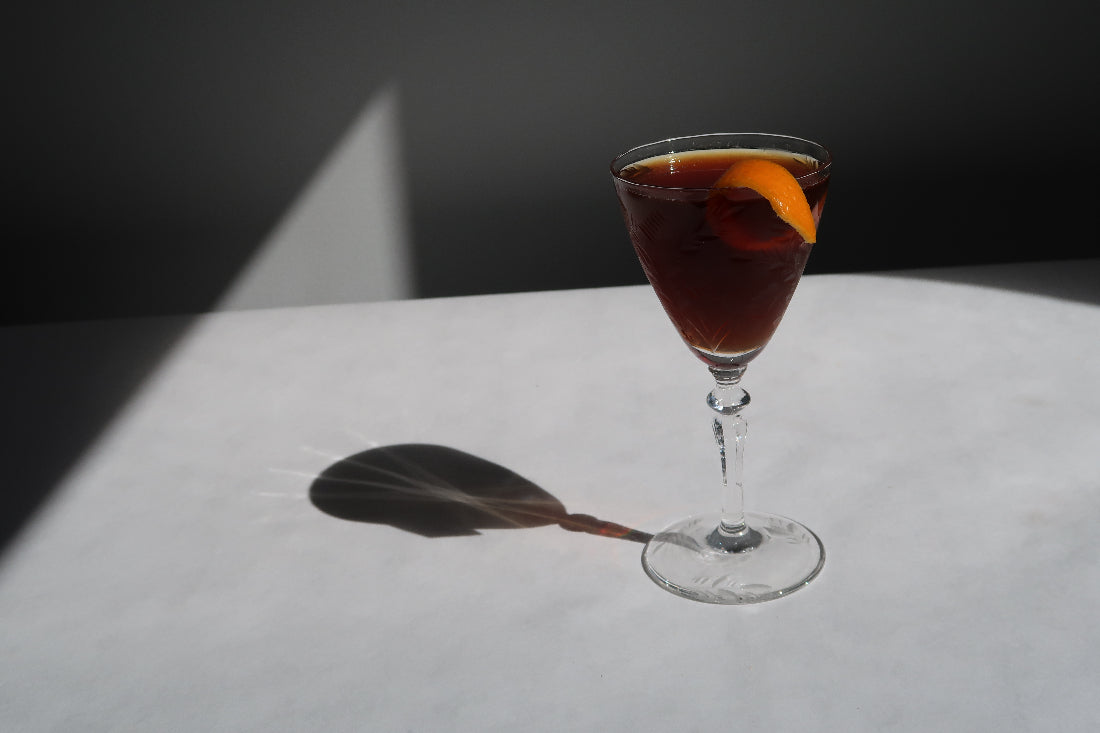We're exploring twelve seasonally-inspired cocktail recipes this year alongside our candle subscription with writer, historian, and cocktail creative Al Culliton.
Simple & Non-alcoholic Versions: Here
New to cocktail making?
Read our Drinks101 post first.
This is the twelfth and final installment of our Labors of the Month series. We’ve seen an entire year through the rhythms of medieval European life, from winter feasts through spring’s preparing of the land; summers full of long days in the fields; and fall, when we reap the harvest and prepare for the dark days ahead. In December, the focus is on getting ready for the Christmas season’s weeks of feasting and, in the final week, getting down to the business of merriment.
Unlike modern Christmas traditions, where the season begins about a month before the holiday, medieval Europeans were still busy finishing up the year’s agricultural work. At this time, the Christmas season actually began on Christmas Day and went for a minimum of two weeks, but often continued on through the month of January. And it was not a children’s holiday. It was absolute debauchery.

The labors depicted for December often involve slaughtering the hogs that were so dutifully brought out into the woods to feast on acorns during November. There’s boar hunting, too. Meat, after all, was central to these large holiday meals. There are also some examples that show the giving of gifts to the king or to local gentry. This may seem a bit lopsided (it was — it was feudalism!), but there were other traditions that involved noblemen distributing their riches in the form of food, drink, or money to the people in their area. Time off, too, would have been a huge treat to those who had been working the land for the past nine months. All of these traditions fit right in with our Keap themes this month — giving, communing, and celebrating — be it in preparing to gather and celebrate or in the giving of gifts within the community.

Stained glass window “December,” 15th century, England. Source
This month’s cocktail, Festum, is a riff on a classic template: the Manhattan. In these darkest days of the year, there’s nothing quite so comforting as a stirred, spirit-forward drink, and all the better if it incorporates traditional holiday flavors. Cognac makes for a silky-smooth base, which is bolstered by herbal sweet vermouth. Amaro stands in for bitters and can lend a variety of notes depending on the brand and style, from pine to spices to kola nut. A small measure of crème de cacao and an orange twist provide familiar flavors of the season.

It’s been such a pleasure writing to you about the Labors of the Month and mixing up some great drinks with you this year. A fitting end, I think, is the following excerpt from a fifteenth-century poem about the Labors:
January – By this fire I warm my hands,
February – And with my spade I delve my lands.
March – Here I set my things to spring,
April – And here I hear the birds sing.
May – I am light as a bird on bough,
June – And I weed my corn well enow.
July – With my scythe my mead I mow,
August – And here I shear my corn full low.
September – With my flail I earn my bread,
October – And here I sow my wheat so red.
November – At Martinmas I kill my swine,
December – And at Christmas I drink red wine.
Wishing you a beautiful holiday season full of festivities, and a very happy new year.


Festum
A Manhattan riff with Cognac, Italian (“sweet”) vermouth, crème de cacao, and amaro in place of traditional bitters, garnished with an orange twist; this one is just as at home before a meal as it is after
- 1 ½ oz. Cognac
- ¾ oz. sweet vermouth
- ½ oz. amaro
- 1 teaspoon crème de cacao
- Orange twist, for garnish
Combine all in a mixing glass and fill three-quarters full with ice. Stir for 20 seconds. Strain into a Nick and Nora glass or coupe. Cut a piece of orange peel (about 3”x1”) using a vegetable peeler. Express the oils from the peel onto the surface of the drink. Rub oily side of peel around the lip of the glass, then twist into a spiral and place in drink, with one end hanging over the side of the glass.

Drinks 101
ON MANHATTANS
The Manhattan cocktail emerged around 1880. At this time, vermouth was a new ingredient in the bartenders’ palette, marking a new era in drinks where stirred, spirit-forward cocktails came to the fore. The Manhattan is actually an offshoot of the vVermouth cCocktail, which consisted of sweetened, diluted sweet vermouth from Italy spiced with bitters. Because this combination is very low-ABV, mixologists at the time wondered how they could make it stronger. Rye, which was the preeminent American whiskey at the time (bourbon’s rise came later), provided the solution, and the Manhattan was born. Since then, it has been a major template that has spawned many variations, including the martini and Rob Roy. It continues to be a muse for many bartenders today.

THIS MONTH'S SIMPLER RECIPE
Looking for a simpler twist or a non-alcoholic option?
Simple recipe: In a mixing glass, combine 2 oz. Cognac with 1 oz. sweet vermouth and 2 dashes of Angostura bitters. Add plenty of ice and stir for 20 seconds. Garnish with an orange twist.
Non-alcoholic version: In a shaker, combine 1 oz. orange juice, ½ oz. lemon juice, and ¾ oz. simple syrup. Shake vigorously for 10 seconds and strain into a Collins glass. Add ice and top with soda water. Garnish with a few dashes of Angostura bitters.














